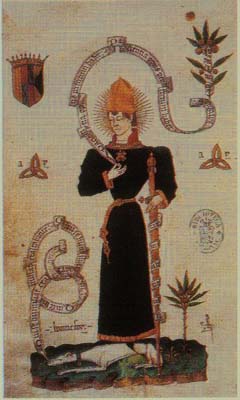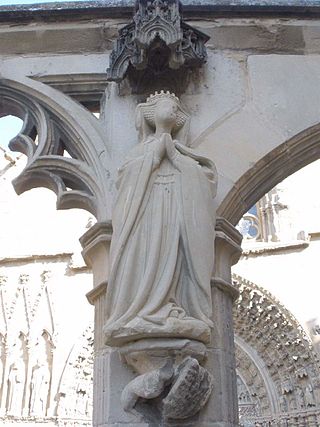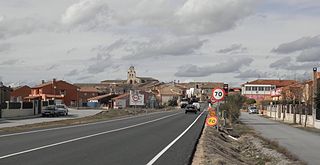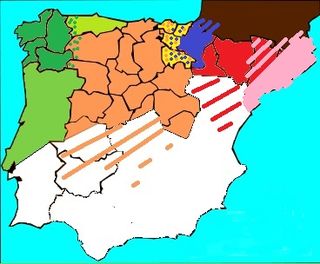
Pamplona, historically also known as Pampeluna in English, is the capital city of the Chartered Community of Navarre, in Spain.

Charles III, called the Noble, was King of Navarre from 1387 to his death and Count of Évreux in France from 1387 to 1404, when he exchanged Évreux for the Duchy of Nemours.

Charles, Prince of Viana, sometimes called Charles IV of Navarre, was the eldest son of King John II of Aragon and Queen Blanche I of Navarre. He pre-deceased his father.

The Kingdom of Navarre, originally the Kingdom of Pamplona, was a kingdom that occupied lands on both sides of the western Pyrenees, with its northernmost areas originally reaching the Atlantic Ocean, between present-day Spain and France.

John III was jure uxoris King of Navarre from 1484 until his death, as husband and co-ruler of Queen Catherine.
Peralta is a town and municipality located in the province and autonomous community of Navarre, northern Spain. It is located 59.5 km from Pamplona, and is on the River Arga, a tributary of the Aragon River which itself flows into the Ebro. The population in 2020 was 5951 (INE) inhabitants. Peralta is one of twenty-seven municipalities that make up the Merindad de Olite in the southern part of Navarre.

Tafalla is a town and municipality located in the province and autonomous community of Navarre, northern Spain. Tafalla lies 30 km south of Pamplona, in the valley of the Zidacos river, which is a tributary of the Aragón. The population in January 2022 was 10,576.

Eleanor of Navarre,, was a Navarrese princess and monarch. She served as the regent of Navarre from 1455 to 1479, during the absence of her father, and then briefly as the queen regnant of Navarre in 1479. She was crowned on 28 January 1479 in Tudela.

Eleanor of Castile was Queen of Navarre by marriage to King Charles III of Navarre. She acted as regent of Navarre during the absence of her spouse in France in 1397–1398, 1403–1406 and 1409–1411.

Blanche I was Queen of Navarre from the death of her father, King Charles III, in 1425 until her own death. She had been Queen of Sicily from 1402 to 1409 by marriage to King Martin I, serving as regent of Sicily from 1404 to 1405 and from 1408 to 1415.

Joan of France, also known as Joan or Joanna of Valois, was Queen of Navarre by marriage to Charles II of Navarre. She was the daughter of John II of France, and Bonne of Luxembourg. She served as regent of Navarre during the absence of Charles II between 1369 and 1372.

Spanish Gothic architecture is the style of architecture prevalent in Spain in the Late Medieval period.

Santa María la Real de Nieva is a municipality located in the province of Segovia, Castile and León, Spain, about 30 km (18 mi) northwest of Segovia town. According to the 2010 census (INE), the municipality had a population of 1,193 inhabitants.

The Palace of the Kings of Navarre of Olite or Royal Palace of Olite is a castle-palace in the town of Olite, in Navarre, Spain. It was one of the seats of the Court of the Kingdom of Navarre, since the reign of Charles III "the Noble" until its conquest by Castile (1512).
Surely there is no king with a more beautiful castle or palace and with so many gilded rooms (...) it could not say or even could imagine how magnificent and sumptuous is this palace (...)
Palacio de los Reyes de Navarra may refer to:
Antonio Carrillo de Peralta y de Velasco, II Marquis of Falces, deceased in 1545, Marcilla, Navarra, Spain, was the son of Navarrese Conetable of the kingdom of Navarre Alonso Carrillo - Acuña y de Peralta, 1st Marquis of Falces, 2nd Count Consort of Santisteban de Lerín, Sieur Consort of Peralta, Falces, Carcer, and other Navarrese places, deceased and buried at Marcilla, Navarre, in 1534.

Navarro-Aragonese was a Romance language once spoken in a large part of the Ebro River basin, south of the middle Pyrenees; the dialects of the modern Aragonese language, spoken in a small portion of that territory, and the Navarrese dialect can be seen as its last remaining forms. The areas where Navarro-Aragonese was spoken might have included most of Aragon, southern Navarre, and La Rioja. It was also spoken across several towns of central Navarre in a multilingual environment with Occitan, where Basque was the native language.

The 1979 Navarrese foral election was held on Tuesday, 3 April 1979, to elect the Foral Parliament of Navarre. All 70 seats in the Parliament were up for election. The election was held simultaneously with local elections all throughout Spain.
San Pedro is a Romanesque and Gothic-style, Roman Catholic church, located on Calle El Fosal 2 in Olite, region of Navarre, Spain.

Spanish Romanesque designates the Romanesque art developed in the Hispanic-Christian kingdoms of the Iberian Peninsula in the 11th and 12th centuries. Its stylistic features are essentially common to the European Romanesque although it developed particular characteristics in the different regions of the peninsula. There is no Romanesque art in the southern half of the peninsula because it remained under Muslim rule (Al-Andalus). The examples of Romanesque buildings in the central area of the peninsula are sparse and of the latest period, with virtually no presence south of the Ebro and the Tagus. Most Romanesque buildings can be found in the northern third of the peninsula. Romanesque art was introduced into the peninsula from east to west, so scholars have usually defined regional characteristics accordingly: the "eastern kingdoms" comprising the Pyrenean areas, Catalan Romanesque, Aragonese Romanesque and Navarrese Romanesque, and the "western kingdoms" comprising Castilian-Leonese Romanesque, Asturian Romanesque, Galician Romanesque and Portuguese Romanesque.




















